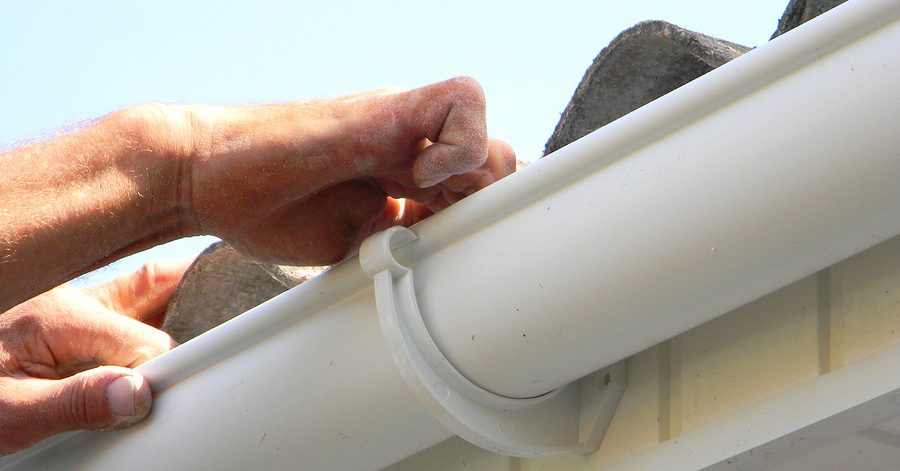Top 6 DIY Gutter Installation Mistakes You Can Avoid With Ned Stevens

Do-it-yourself gutter installation at your home may seem like a viable way to cut costs and save money. However, there’s much more than what meets the eye when it comes to proper gutter installation. Far too often, we’ve received distressed calls from our customers who attempted to turn what should be done by experienced professionals into a DIY weekend job.
Simply put, there are an endless number of things that can go wrong when you don’t have experience hanging gutters. Making a mistake, for example, with measurements or using the wrong material or tools can cause damage to your property or require a do-over to get it right. This may mean buying a fresh set of materials or extra miscellaneous expenses.
On the other hand, the installation may “appear” to go well but the gutters are not as functional or efficient as they should be in channeling water off the roof. This could result in water damage and costly repairs or replacement.
When it comes to DIY gutter installation mistakes, we’ve seen it all. Here are a few of the most common DIY gutter installation mistakes you can avoid by hiring the pros at Ned Stevens Gutter Cleaning of Long Island.
Choosing Wrong Type of Gutter Is a DIY Gutter Install Error
Buying gutters could be a confusing task when you realize that they are not one-size-fits-all. In fact, they come in various lengths and widths, shapes, gauges, and materials. Some are also more durable than others. While the current trend favors 5 to 6-inch K-style aluminum gutter, the design of your house or pitch of the roof could require a different style or size. The location of your home and the amount of rainfall in your city are other factors to be considered when making a selection.
Improper Pitch Is a Common DIY Gutter Installation Mistakes
Speaking of roof pitch, gutters need to be perfectly pitched or angled to ensure they effectively collect water and channel it to the downspouts without causing an overflow. The experts know that these calculations are important to avoid this mistake many homeowners make. While the pitch should be slight, angling a bit too high or a bit too low along the length of the gutter can cause problems such as overflows.
The suggested pitch is a 1-2 inch slope for every 40 feet of gutter. This ensures it is not tilted too backward or too forward. If you’re considering a DIY gutter installation, make sure you brush up on your fractions, algebra and geometry!
Wrong Positioning Is a Common DIY Gutter Installation Error
Another frequent mistake is a wrongly positioned gutter system. The natural assumption is that water should flow smoothly once the gutters are attached at the edge of the roof. However, gutters are typically installed a few inches lower than the actual roof deck.
If the gutter is positioned too low, runoff water can drip down its rear side due to what is known as capillary action. This can then cause damage such as water-soaked or rotted fascia boards, stains on the siding, or damage to the soffit. When necessary, the experts at Ned Stevens Gutter Cleaning of Long Island can avert this potential problem by installing a drip edge under the first line of shingles.
Incorrect Hanger Spacing Is a Typical DIY Gutter Installation Mistake
In addition to sloping the gutters correctly, the gutter hangers must be properly positioned. This alone can make the job begin to seem more complex than you might have initially thought. Well, it is, and so is the possibility of making a mistake.
Hangers help to keep the gutter sturdy, but too often homeowners doing a DIY skimp on the amount needed for adequate spacing. As a general rule, hangers should not be placed more than 2 to 2 ½ feet apart from each other. Otherwise, the risk of sagging increases as well as the chance for the gutter to break from the weight of the rainwater or excess debris. Winter snow and ice can add significant weight to the gutters so having the right support can be crucial.
Choosing Too Many Seams Is a DIY Gutter Install Err
A seam is formed at the joint where two pieces of gutter lengths are connected with caulking. Leaks, clogs, cracks or complete separation is also more likely to occur at the seam since it is the weakest part of the structure. To reduce the risk of breakage, the number of gutter seams should be kept at a minimum.
Alternatively, you can opt for seamless gutters which can be customized to suit your needs. Due to having fewer joints or seams, they do not accumulate as much debris as sectional gutters. They also require less maintenance throughout the year, and since there are fewer seams, there are fewer chances for leaky gutters.
DIY Installation Mistakes & Damage
Rain gutters are made from various types of materials including aluminum, zinc, copper, and vinyl. But they each have a different level of durability, different tools and parts and different variations of installation methods. Inexperience will often cause the gutters to be damaged during a DIY installation.
An aluminum gutter is more likely to get dented or bent out of shape, especially since it is lightweight. Incidentally, it is also a preferred choice of DIYers because it is easy to install. However, failure to handle your gutter with care can end up costing you money to get it replaced.
Contact Ned Stevens Gutter Cleaning of Long Island
The bottom line is gutters that aren't properly installed can end up doing the opposite of what they are intended to do. That is to protect your property and foundation from structural damage. Instead of rolling this very expensive set of dice, leave the gutter installation to the pros!
Contact Ned Stevens Gutter Cleaning of Long Island today for a free consultation.

